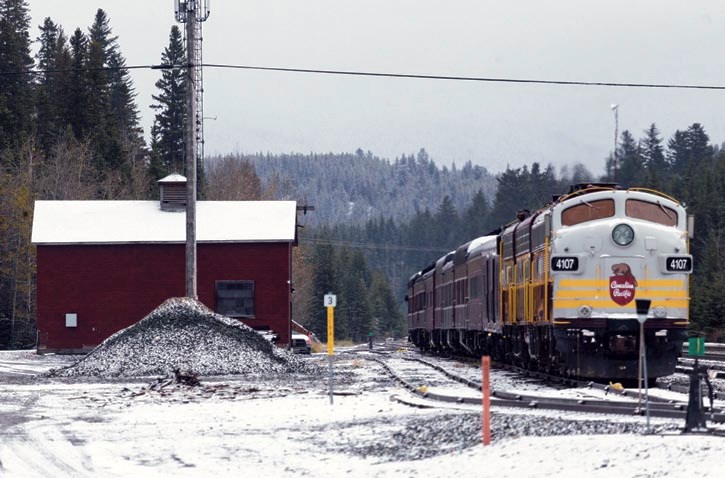BANFF – The provincial government seems open to the idea of mass transit between Calgary and Banff.
Last week, a feasibility study commissioned by Banff, Canmore, ID9, Cochrane and Calgary, determined all-year bus and rail mass transit is feasible, but couldn’t move forward without support from other levels of government.
Banff-Cochrane MLA Cam Westhead said the government is looking forward to reviewing the findings of the study and hearing what the municipalities involved have to say, noting the government is committed to enhancing transit options.
“I know the government is always looking at ways to improve transit options,” he said, noting mass transit would also help with affordability issues for people travelling between the Bow Valley and Calgary.
“This helps reduce greenhouse gas emissions, helps with reducing traffic congestion in our destination and helps gives visitors a better impression and be able to enjoy their experience more.”
The feasibility study’s partnership group hasn’t selected a preferred mode of mass transit and is looking to set up a regional working group to determine next steps.
“The feasibility study states fairly clearly that mass transit is going to have to have support both provincially and federally at some point,” said Mayor Karen Sorensen. “Those conversations will take place.”
To make way for the return of passenger rail, a new track along Canadian Pacific’s right-of-way would need to be built, subject to reaching an agreement with CP. Terminating at Banff, there would be train stops along the way, including Cochrane, Stoney Nakoda and Canmore.
In the 1980s, VIA operated between Calgary and Banff. The new mass transit study put forward a scenario of eight round trips per day from Calgary to Banff in the summer and six in
the winter.
Conservation groups are disappointed the study didn’t look at environmental implications, such as the effects of a new passenger railway line along CP’s right-of-way on wildlife in the Bow Valley.
Given that trains kill wildlife, including grizzly bears in Banff National Park, the Alberta Wilderness Association believes it’s unacceptable for a feasibility study to ignore the impact of a new railway line on wildlife.
“We know that train strikes killed more than a dozen grizzly bears from 2000 to 2017, a significant percentage of Banff National Park’s grizzly population,” said AWA’s Ian Urquhart, noting conservation groups want to be part of the consultations.
“Hundreds of elk, deer, and black bears have perished this way. But this study, funded by $350,000 from the provincial government, devotes no thought whatsoever to the impact more, and faster, trains through the Bow Valley will have on wildlife.”
There are currently about 24 trains per day on CP’s main line between Calgary and Banff and Lake Louise, according to the authors of the study.
“Consultations with CP confirmed that these are the current order of magnitude volumes on a typical day, though noted that they can be significantly higher on days following recovery from a track outage, such as an avalanche in the mountains,” states the report.
“In the short-term, it is anticipated that freight traffic levels, on average, would not increase significantly beyond the 24 trains per day … However, given the length of time required for rail service implementation, there is the possibility of rail traffic to increase.”
To this end, the study indicated that CP has noted a dedicated passenger rail line that does not allow for freight operations would potentially constrain, or make it more costly for CP to expand its corridor in future.
“However, it could be explored how CP could utilize some of the capacity of the dedicated line overnight to mitigate this concern, and potentially have the option of repurchasing the line after a defined period for CP’s primary use (e.g. 25 years),” stated the feasibility study.
Next up, Banff administration plans to bring a report to council asking for direction.
If the municipalities decide to move ahead with mass transit, Town of Banff officials say environmental impact assessments would be a significant part of the work to determine which mode, which routes and stops.
“In short, the study is the first step, much more work would need to occur, including environmental assessments,” said Jason Darrah, the Town of Banff’s communications and marketing director.
Banff’s Adam and Jan Waterous, through their personal financial holding company, Liricon Capital, have already secured about $700 million to go towards capital costs of a new line for passenger trains from Calgary to Banff.
Having bought the lease for the train station and surrounding 32 acres of land, the couple’s goal is to create a transit hub at Banff’s west entrance, which includes a return of passenger rail and an aerial gondola to Mount Norquay.
Work has already begun to make way for a new paved intercept lot at the train station in time for the busy summer season.
“The plan is to be ready for July 1,” said Jan Waterous.




